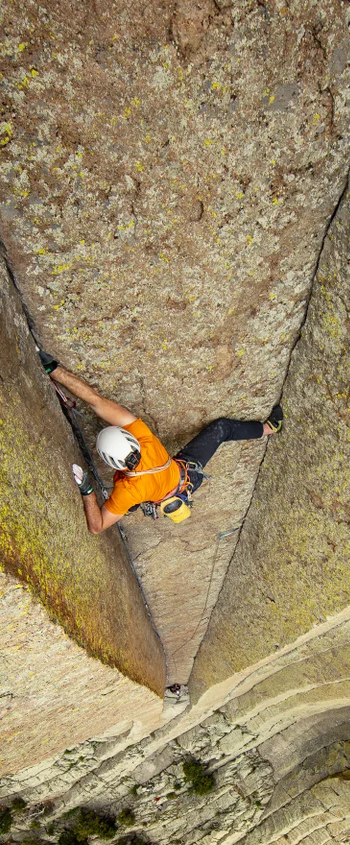We Turned an Abandoned Church Into a Skatepark. Then Tragedy Struck.
I found out that our place of worship was burning around 2 a.m. I woke up to seven missed calls and over 50 messages. If the texts hadn’t come with pictures of the bell tower engulfed in flames, I wouldn’t have believed them. Everyone is safe, but it’s destroyed. The fire is still going. Church is gone. For years the place had been our sanctuary, and now it was ash.
Back when we were still St. Louis kids and before we had kids of our own, my friends talked about turning the long-abandoned Catholic church into a skate park. We grew up together in a pack of feral teenagers who skated up and down Delmar Boulevard, the east-west artery that cuts through the city. We loitered outside the Shell station and Racanelli’s Pizza and Vintage Vinyl. We sat in piles of wrists and legs and hormones to claim our space on the concrete. They called us the Loop Rats, just a bunch of dirty pests the store owners had to shoo away from their doors.
Like a lot of young people who grow up in uncool places, I thought I had to get to a shiny metropolis to build success. For over a decade, I chased achievement elsewhere: New York City, Los Angeles, Boston. But it was in returning home that I became a part of building something increasingly rare and meaningful: a community.
A few years ago, my friends and I pooled our resources to turn St. Liborius Church, a nationally registered historical site and the largest Gothic revival church west of the Mississippi, into a community space. Trying to develop a skate park inside a massive church was never a part of my five-, 10- or any-year plan. But I fell in love with the idea of giving a new generation of St. Louis kids a spectacular place where they would be welcome and where no one would ever shoo them away.

Transforming St. Liborius into Sk8 Liborius was a D.I.Y. effort. The good part about living in an undesirable place is the same as the bad part: No one cares what’s happening here. This is mostly hard, like when jobs dry up and infrastructure crumbles. But it also means that unlike in America’s aspirational cities, where creativity is reserved for the rich and their children, large-scale creative projects are still accessible to the non-generationally wealthy. No one is coming to repair America’s forgotten cities except for the people who live in them. In St. Louis alone, there are about 25,000 abandoned buildings. The überrich would rather visit Mars than save St. Louis.
So for years, we hauled shovelfuls of dead pigeon carcasses out of the corners of the church to clear space for construction. We called ourselves the Dead Pigeon Club, and some people even got tattoos of them, still punk even when pushing 40. I almost had a panic attack when one very alive pigeon flew uncomfortably close to my face in the bell tower. Hundreds of local volunteers lent their skills to this project. They ran the gamut from tradespeople who spent their Sundays tuckpointing, welding and laying concrete to office workers who researched 501(c) funding and historical building grants and talked to lawyers.
Although the process of building Sk8 Liborius took over a decade, our community found national attention only this summer.Predictably, it was because something tragic happened.
Before the four-alarm fire, Sk8 Liborius was a beautiful place in a place not known for beauty. Some of the church’s original stained glass was still intact. Cobalt blue, canary yellow and rose hues depicted the stories of the New Testament. A partly shattered portrait of Mother Mary, a tree branch peeking through her left eye. If you bit it on a ramp, as you lay on your back, the gold mosaic ceiling tiles comforted you with their sacred geometry.
The walls were adorned with murals by local artists. The only rule was: No covering up the original religious artwork, so lunettes more than 100 years old floated above graffiti tags like “STL Punk.” It was impossible not to feel the Holy Spirit when you were walking through the cross-shaped open space that led to the altar, where dozens of broken skateboards lay in sacrifice.
Skateboarding is naturally a socially inclusive sport, and the “congregation” that formed was welcoming to all. Teenagers from impoverished parts of North St. Louis skated alongside pro international skateboarders who sought out the church as a destination. A free yoga class met on occasion. Rappers, metal bands and dubstep D.J.s all performed there. A crew of queer quad skaters came religiously. Local parents brought their toddlers to ride around on tricycles. One roller skater preferred the comfort of a dinosaur costume. Nuns who had been part of the church before it was abandoned by the archdiocese in 1992 would visit, thrilled to see the church playing an active role in the community again. It was a place where people could feel safe and be free.

The goal had been to save the church, but now it was gone, and we’d failed. Our years of relentless optimism had turned to rubble. It was crushing. The fact that it ever existed at all was a miracle. Proof that transformation is possible anywhere. Even in the land of vacant lots, Dollar Tree stores, dusty red brick buildings and payday loan signs.
A community isn’t a building, and St. Louis is shockingly resilient. In the days that followed the fire, we held emergency community meetings. Over 200 volunteers showed up to secure the building and clean up the mess the fire left behind in the neighborhood. A group of grade schoolers raised money to pay for supplies with a lemonade stand. We are planning on rebuilding. After all, who but us is interested in making our particular patch of unwanted earth more beautiful?




